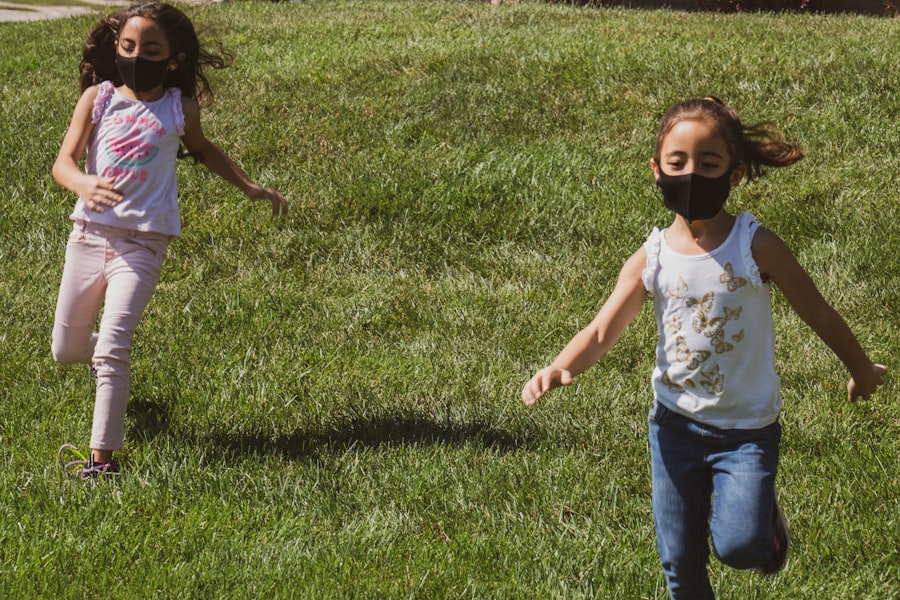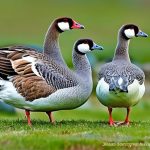Playgrounds are a place for children to have fun and be active. They provide a safe and enjoyable environment for kids to play, climb, and explore. However, the presence of geese on playgrounds can pose health risks and safety concerns for children and adults alike. Geese are attracted to open spaces with water and grass, which are often features of playgrounds. Additionally, geese may be attracted to food and garbage left behind by humans. Therefore, it is important to take steps to prevent geese from entering playgrounds in order to ensure a safe and enjoyable experience for all.
Key Takeaways
- Geese on playgrounds pose health risks and safety concerns.
- Understanding geese behavior can help prevent them from entering playgrounds.
- Fencing and other physical barriers can keep geese out of playgrounds.
- Visual and sound-based deterrents can also be effective in keeping geese away.
- Educating children and adults on how to avoid attracting geese is important for playground safety.
Understanding the Behavior of Geese and Why They are Attracted to Playgrounds
Geese are migratory birds that are commonly found in parks, lakes, and other open spaces. They are attracted to playgrounds because they provide the ideal habitat for them. Playgrounds often have open spaces with water features such as ponds or fountains, as well as grassy areas for grazing. These features make playgrounds a prime location for geese to rest, feed, and breed.
In addition to the natural features of playgrounds, geese may also be attracted to food and garbage left behind by humans. Geese are opportunistic feeders and will eat a variety of foods, including grass, grains, insects, and even human food scraps. If people regularly feed geese in or near playgrounds, it can create a strong attraction for them to return.
The Dangers of Geese on Playgrounds: Health Risks and Safety Concerns
While geese may seem harmless, they can actually pose several health risks and safety concerns when they are present on playgrounds. Geese can carry diseases such as E. coli and salmonella, which can be transmitted through their droppings or direct contact with the birds themselves. These diseases can cause serious illness in humans, especially in young children whose immune systems may not be fully developed.
Furthermore, geese droppings can contain harmful bacteria that can contaminate the playground equipment and surfaces. This can increase the risk of infection if children come into contact with the droppings or touch contaminated surfaces and then put their hands in their mouths.
Geese can also become aggressive and attack humans, especially during nesting season when they are protecting their eggs or young goslings. Their large size and sharp beaks can cause injury, particularly to small children who may not be able to defend themselves.
Tips for Preventing Geese from Entering Playgrounds
Preventing geese from entering playgrounds requires a proactive approach. Here are some tips to help keep geese away:
1. Keep playgrounds clean and free of food and garbage: Regularly clean up any food scraps or garbage left behind by humans. This will remove a potential food source for geese and discourage them from staying in the area.
2. Use landscaping to make the area less attractive to geese: Planting shrubs or tall grasses around the perimeter of the playground can create a natural barrier that makes it less appealing for geese to enter. Geese prefer open spaces where they have a clear line of sight, so creating obstacles can deter them from entering.
3. Implement a no-feeding policy for geese in the area: Educate the public about the dangers of feeding geese and implement a policy that prohibits feeding them in or near playgrounds. This will help reduce the attraction for geese and discourage them from frequenting the area.
Installing Fencing and Other Physical Barriers to Keep Geese Out
Fencing can be an effective way to keep geese out of playgrounds. A fence should be at least three feet high and have small openings or mesh to prevent geese from squeezing through. It should also be securely anchored to the ground to prevent geese from going under it.
In addition to fencing, other physical barriers such as netting and hedges can also be used to keep geese out. Netting can be installed over water features to prevent geese from landing or swimming in them. Hedges can be planted around the perimeter of the playground to create a natural barrier that geese are less likely to cross.
It is important to regularly inspect and maintain these physical barriers to ensure they remain effective. Any gaps or damage should be repaired promptly to prevent geese from finding a way in.
Using Visual Deterrents to Scare Geese Away from Playgrounds

Visual deterrents can be effective in scaring geese away from playgrounds. These deterrents take advantage of the geese’s natural instincts and fear of predators. Here are some examples of visual deterrents that can be used:
1. Decoys: Placing decoy predators such as plastic owls or coyotes in the area can make geese think there is a threat present and discourage them from staying. It is important to move the decoys regularly to prevent geese from becoming accustomed to them.
2. Reflective tape: Hanging strips of reflective tape or shiny objects around the playground can create a visual disturbance that scares geese away. The movement and reflection of light can make geese feel uneasy and encourage them to find another location.
3. Scarecrows: Traditional scarecrows can also be effective in deterring geese. The presence of a human-like figure can make geese feel threatened and encourage them to leave the area.
Implementing Sound-Based Deterrents to Keep Geese at Bay
Sound-based deterrents can be another effective method for keeping geese away from playgrounds. These deterrents use loud noises or sounds that mimic predators to scare geese away. Here are some examples of sound-based deterrents that can be used:
1. Sirens or alarms: Installing sirens or alarms that can be activated remotely can startle geese and make them feel threatened. However, it is important to use these deterrents sparingly to avoid disturbing nearby residents.
2. Ultrasonic devices: Ultrasonic devices emit high-frequency sounds that are unpleasant to geese but not audible to humans. These devices can be placed around the perimeter of the playground to create a sonic barrier that discourages geese from entering.
3. Water sprayers: Motion-activated water sprayers can be installed near the playground to startle geese with a sudden burst of water. This can be an effective deterrent, especially if the geese have become accustomed to other methods.
Educating Children and Adults on How to Avoid Attracting Geese to Playgrounds
Education is key in preventing geese from being attracted to playgrounds. Children and adults should be taught not to feed geese or leave food and garbage in the area. They should also be taught to avoid approaching geese and their nests, as this can provoke aggression.
Signage can be posted around the playgrounds to remind visitors of these guidelines and the potential risks associated with geese. Additionally, educational programs or workshops can be organized to raise awareness about the importance of keeping geese away from playgrounds and how to do so effectively.
Working with Local Wildlife Authorities to Manage Geese Populations in the Area
Managing geese populations in the area may require assistance from local wildlife authorities. They can provide guidance on effective methods for deterring geese and may even be able to assist with relocating geese if necessary.
It is important to work collaboratively with wildlife authorities to ensure that any management strategies are humane and comply with local regulations. They can also provide valuable information on the migratory patterns and behavior of geese in the area, which can help inform prevention and management efforts.
Ensuring a Safe and Enjoyable Playground Experience for All
By taking steps to prevent geese from entering playgrounds, we can ensure a safe and enjoyable experience for children and adults alike. Geese can pose health risks and safety concerns, so it is important to be proactive in managing their presence. This includes keeping playgrounds clean, implementing physical barriers, using visual and sound-based deterrents, educating the public, and working with local wildlife authorities.
By following these guidelines and working together, we can create playgrounds that are free from the dangers and disruptions caused by geese. This will allow children to play and explore in a safe environment, while also preserving the natural habitats of geese and other wildlife.
If you’re looking for effective ways to keep geese off the playground, you might also be interested in learning about chicken coops and how they can benefit your backyard. Poultry Wizard offers a variety of informative articles on chicken coop designs and maintenance. One article that caught my attention is “The Chicken Coop Country Diner,” which explores the concept of combining a chicken coop with a functional outdoor dining area. It’s a fascinating read for anyone interested in creating a multi-purpose space that not only provides shelter for chickens but also enhances your outdoor living experience. Check it out here.
FAQs
What are the common problems caused by geese on playgrounds?
Geese can leave behind droppings that can be unsanitary and slippery, which can cause health hazards and accidents. They can also be aggressive towards children and adults, especially during nesting season.
What are some effective ways to keep geese off playgrounds?
Some effective ways to keep geese off playgrounds include installing physical barriers such as fences or netting, using noise deterrents such as loudspeakers or alarms, and using visual deterrents such as decoys or reflective tape.
Are there any humane methods to keep geese off playgrounds?
Yes, there are humane methods to keep geese off playgrounds. These include using natural deterrents such as planting tall grass or shrubs, using water deterrents such as sprinklers or water cannons, and using trained dogs to chase away geese.
What should I do if I encounter an aggressive goose on a playground?
If you encounter an aggressive goose on a playground, it is important to stay calm and avoid making sudden movements. Slowly back away from the goose and give it plenty of space. Do not attempt to feed or touch the goose, as this can provoke it further.
Why is it important to keep geese off playgrounds?
It is important to keep geese off playgrounds to ensure the safety and health of children and adults who use the playground. Geese can leave behind unsanitary droppings and be aggressive towards people, which can cause health hazards and accidents.
Meet Walter, the feathered-friend fanatic of Florida! Nestled in the sunshine state, Walter struts through life with his feathered companions, clucking his way to happiness. With a coop that’s fancier than a five-star hotel, he’s the Don Juan of the chicken world. When he’s not teaching his hens to do the cha-cha, you’ll find him in a heated debate with his prized rooster, Sir Clucks-a-Lot. Walter’s poultry passion is no yolk; he’s the sunny-side-up guy you never knew you needed in your flock of friends!







